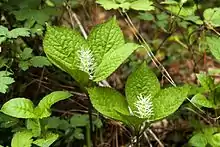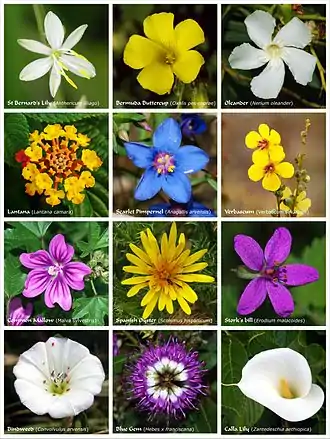Chloranthaceae
Chloranthaceae /ˌklɔːrænˈθeɪʃiː/ is a family of flowering plants (angiosperms), the only family in the order Chloranthales.[1] It is not closely related to any other family of flowering plants, and is among the early-diverging lineages in the angiosperms. They are woody or weakly woody plants occurring in Southeast Asia, the Pacific, Madagascar, Central and South America, and the West Indies. The family consists of four extant genera, totalling about 77 known species according to Christenhusz and Byng in 2016.[2] Some species are used in traditional medicine. The type genus is Chloranthus. The fossil record of the family, mostly represented by pollen such as Clavatipollenites, extends back to the dawn of the history of flowering plants in the Early Cretaceous, and have been found on all continents.[3]
| Chloranthaceae | |
|---|---|
 | |
| Sarcandra glabra | |
 | |
| Chloranthus fortunei | |
| Scientific classification | |
| Kingdom: | Plantae |
| Clade: | Tracheophytes |
| Clade: | Angiosperms |
| Order: | Chloranthales R.Br.[1] |
| Family: | Chloranthaceae R.Br. ex Sims[1] |
| Genera | |
| |
Description
Chloranthaceae are fragrant shrubs or herbaceous plants, that only produce side branches on the new growth. The stems are mostly cylindrical, with solid internodes, thickened nodes in many species, that carry evergreen leaves arranged in pairs on opposite sides of the stem, with stipules that have merged with that of the opposing leaf. The small flowers are seated directly on the axis of the inflorescence. Petals are absent in this family, and sometimes so are sepals. The flowers can be either hermaphrodite or of separate sexes. The fruit is drupe or berry, consisting of one carpel.[4]
Differences between the genera
The four genera assigned to this family can be distinguished from each other by the following characters. Sarcandra species are shrubs with wood without vessels, that have bisexual flowers, with only one, club-shaped stamen in which the connective tissue (between the lobes which carry the pollen) is wide, and with a smooth and moist stigma. This genus has four species which occur in Malaysia, China, Indochina, Japan, India, and Sri Lanka. Chloranthus species are dwarf shrubs or herbaceous plants, with xylem that does contain vessels, that has bisexual flowers, each of which containing three stamens on straight, filaments with three lobes and a wide connective, and with a smooth and moist stigma. The twenty species occur in southern and eastern Asia. Ascarina has separate male and female flowers. The male flowers are subtended by two bracts and have between one and five stamens, in which the connective is not widened. The female flower is without bracts, the stigma is dry and covered in papillae. The fruit is a drupe-like berry. Twelve species can be found on islands in the Pacific and insular South-East Asia, from New Zealand and the Marquesas to Borneo, and on Madagascar. Hedyosmum has separate male and female flowers. The male flowers are without bracts and has one stamen in which the connective is not widened. The female flower is without bracts, the stigma is dry and covered in papillae. Female flowers have a trilobed calyx. The fruit has a kernel with a hard and woody shell (a drupe). Forty three species are known from Latin America, including the Antilles, and one species lives in Southeast Asia.
Taxonomy
Chloranthaceae have been recognised as a family in most classifications but without clear relatives. Molecular systematic studies have shown that it is not closely related to any other family and is among the early-diverging lineages in the angiosperms. In particular, it is neither a eudicot nor a monocot. Fossils assigned to Chloranthaceae, or closely related to the family, are among the oldest angiosperms known.[5][6][7] The APG II system (2003) left the family unplaced as to order, but the APG III system (2009) accepted Chloranthales, containing only this family.[1] The cladogram below, from the APG IV system (2016), shows the Chloranthales in a trichotomy with the magnoliids and the monocot-Ceratophyllales-dicot clade. Earlier the order was grouped with magnoliids, but studies in 2014 did not support this placement, so that its phylogeny remains unclear.[8]
| angiosperms |
| |||||||||||||||||||||||||||||||||||||||
A study based on comparison of homologous DNA-fragments, published in 2004 indicated that the both the family Chloranthaceae and its extant genera Ascarina, Chloranthus, Hedyosmum and Sarcandra are probably monophyletic, with Hedyosmum being the first to diverge from the rest, and Ascarina being the sister group of the clade consisting of Sarcandra and Chloranthus. As of June 2016, four extant genera are recognized, and insights in their relationships are expressed in the following tree.[4][9]
| Chloranthaceae |
| |||||||||||||||||||||
The extinct genus Chloranthistemon also belongs to this family.[10]
Historical classifications
The Cronquist system (1981) assigned the family
- to the order Piperales
- in subclass Magnoliidae
- in class Magnoliopsida [=dicotyledons]
- of division Magnoliophyta [=angiosperms].
- in class Magnoliopsida [=dicotyledons]
- in subclass Magnoliidae
The Thorne system (1992) placed it
- in the order Magnoliales, which was assigned
- to superorder Magnolianae
- in subclass Magnoliideae [=dicotyledons],
- in class Magnoliopsida [=angiosperms].
- in subclass Magnoliideae [=dicotyledons],
- to superorder Magnolianae
The Dahlgren system raised the family to be
- its own order Chloranthales, which was assigned
- to superorder Magnolianae
- in subclass Magnoliideae [=dicotyledons],
- in class Magnoliopsida [=angiosperms].
- in subclass Magnoliideae [=dicotyledons],
- to superorder Magnolianae
References
- Angiosperm Phylogeny Group III (2009). "An update of the Angiosperm Phylogeny Group classification for the orders and families of flowering plants: APG III". Botanical Journal of the Linnean Society. 161 (2): 105–121. doi:10.1111/j.1095-8339.2009.00996.x.
- Christenhusz, M. J. M.; Byng, J. W. (2016). "The number of known plants species in the world and its annual increase". Phytotaxa. 261 (3): 201–217. doi:10.11646/phytotaxa.261.3.1.
- Pipo, M.; Iglesias, Ari; Bodnar, Josefina (2020). "New vesselless angiosperm stem with a cambial variant from the Upper Cretaceous of Antarctica". Acta Palaeontologica Polonica. 65. doi:10.4202/app.00697.2019.
- Stevens, P.F. (2001) [onwards]. "Chloranthaceae". Angiosperm Phylogeny Website. Retrieved 2016-06-12.
- Herendeen, Patrick S.; Friis, Else Marie; Pedersen, Kaj Raunsgaard; Crane, Peter R. (2017-03-03). "Palaeobotanical redux: revisiting the age of the angiosperms". Nature Plants. 3 (3): 17015. doi:10.1038/nplants.2017.15. ISSN 2055-0278. PMID 28260783. S2CID 205458714.
- Doyle, James A.; Endress, Peter K. (2018-06-01). "Phylogenetic Analyses of Cretaceous Fossils Related to Chloranthaceae and their Evolutionary Implications". The Botanical Review. 84 (2): 156–202. doi:10.1007/s12229-018-9197-6. ISSN 1874-9372. S2CID 46980346.
- Friis, Else Marie; Crane, Peter R.; Pedersen, Kaj Raunsgaard (2019-03-01). "Hedyosmum-Like Fossils in the Early Cretaceous Diversification of Angiosperms". International Journal of Plant Sciences. 180 (3): 232–239. doi:10.1086/701819. ISSN 1058-5893.
- Angiosperm Phylogeny Group (2016). "An update of the Angiosperm Phylogeny Group classification for the orders and families of flowering plants: APG IV". Botanical Journal of the Linnean Society. 181 (1): 1–20. doi:10.1111/boj.12385.
- Eklund, Helena; Doyle, James A.; Herendeen, Patrick S. (2004). "Morphological Phylogenetic Analysis of Living and Fossil Chloranthaceae". International Journal of Plant Sciences. 165 (1): 107–151. doi:10.1086/380987. JSTOR 10.1086/380987.
- Herendeen, P. S.; Crepet, W. L.; Nixon, K. C. (1993). "Chloranthus-like stamens from the Upper Cretaceous of New Jersey". American Journal of Botany. 80 (8): 865–871. doi:10.1002/j.1537-2197.1993.tb15306.x.
External links
- Chloranthaceae in L. Watson and M.J. Dallwitz (1992 onwards) The families of flowering plants: descriptions, illustrations, identification, information retrieval. Version: 3 May 2006. https://web.archive.org/web/20070103200438/http://delta-intkey.com/.
- Andes Trees
- NCBI Taxonomy Browser
- Images of Chloranthus Flavon's art gallery: Chloranthaceae
- Image of Chloranthus oldhamii
- Image of Chloranthus serratus
- Images of Sarcandra glabra
